This is a great example of why Graham is Gauld. About 25 years ago, while organizing a road test in Paris, he chats with a Hotel Manager at de Gaulle Airport who suddenly talks Gauld into going out the countryside to see an old barn full of old cars. And of course, a story ensues.[Ed.]
By Graham Gauld
As regular readers will know I keep discovering cars and racing people in the most unlikely places. For example, back in the late 1980s I organized a press road test for Fiat UK and based it at one of the airport hotels at Charles de Gaulle airport in Paris. In the lull before the journalists arrived the manager of the hotel, knowing my interest in old cars, suggested we go and see a farming friend of his who had some old cars.
I played along with the idea and when we arrived at this large old farmyard a few miles away from the airport, the first thing that caught my eye were two halves of a German one-man submarine from WWII. The farmer collected all sorts of wartime gems such as Army motorcycles and sidecars, halftrack trucks, vans and the like.
All around me were barns chock full of boring French cars. They were all in states of disrepair and the farmer who owned them – he was in his early sixties at the time – kept pointing to cars and saying he was about to restore this one or that one but clearly it was not going to happen.
However all was not lost. For here, in reasonable condition, were two unique and interesting race cars.
The first, with its futuristic nose, was the 1931 front-wheel drive Chevalier race car that had won the 1934 Bol d’Or at St Germain ahead of Philippe Maillard-Brune’s MG J4. The Chevalier had an 1100cc engine and was one of the earliest front wheel drive race cars. It was raced in the Bol d’Or by Monsieur Chevalier himself and now here it was gathering dust in this farm yard in northern France. In the past thirty years I have kept my eyes open to see if it had been rescued by an enthusiast and was back in running order, but no luck. Perhaps we will see it again sometime.
The other race car was equally quirky as it was built in the late 1940s by French enthusiast Marcel Balsa. Balsa was born in 1909 in the Limousin area of France famous for its cattle and milk production. However, he raced motorcycles and when he was in his mid-thirties he bought a Bugatti T30 and raced it in 1938.The following year he bought a T35B Bugatti and ran it at the Grand Prix of Pau which opened the 1939 Grand Prix season. Here he was up against the full Mercedes Benz factory team of Caracciola, von Brauchitsch and Lang. Despite this, he ran in seventh place in the race, but the Bugatti did not last the pace and he retired after 22 laps. Then the war came along.
During the war Balsa sold his T35 Bugatti, replaced it with a T51A and duly lined up for the first motor race held in Europe after the war, the Coupe de la Liberation at the Bois de Boulogne in Paris. This was not the main race but was for cars up to 2 liters won by Georges Grignard in his C6 Amilcar. As for Balsa, his car retired. That race was followed on the same day the Coupe des Prisonniers, the better known race from that meeting won by Jean-Pierre Wimille with a Tipo 59/50B Bugatti.
Balsa kept the Bugatti and bought a Talbot 150C that he ran in the Grand Prix de Nice in April 1946 and once again he retired. The following month he decided to run the Bugatti again. In the second heat he surprised everyone including the entire Scuderia Milan Maserati team by getting a flyer of a start and leading everyone only to be swallowed up by Raymond Sommer, Enrico Plate and Baron de Graffenried in their Maseratis. But Balsa must have been happy with fifth in the end.
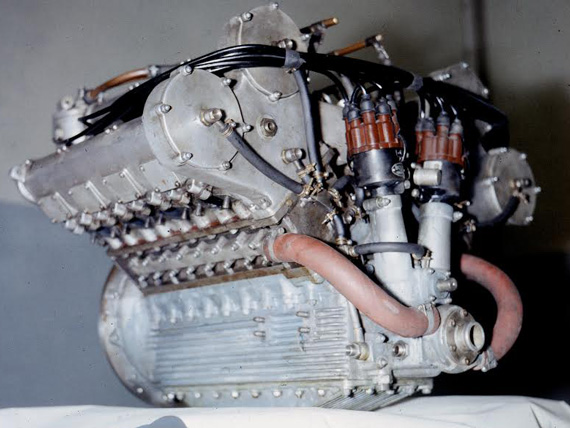
The remarkable 2 liter V8 engine produced by Richard Kuchen in 1950. Could this have fitted in the Balsa ? (Photo courtesy the Ludvigsen Library)
Now we come to the Balsa race car that he built in 1948 initially with a BMW 328 engine. However, this same car that I found in the farmyard shed and photographed had a placard beside it saying that the engine was a V8; as can be seen there are two bulges on the hood that might confirm this. Sadly at the time the farmer did not open the hood so I never actually saw if there was even an engine in the frame. So this got me thinking, what was the V8?
Because Marcel Balsa had BMW links – he drove a borrowed Jicey-BMW in another event – I started to look at the BMW specials in Germany during that period and came across the story of how Hans Stuck had put a Kuchen V8 engine into an East German AFM.
This engine and its development is fascinating. Three were produced and one story goes that two of them went to Stuck and the third remained unclaimed. Obviously, as the Kuchen engine was produced in 1949 I thought that this third engine may have ended up in the Balsa.
There was only one man to ask, my old friend Karl Ludvigsen, who to my mind is the modern authority on V8s. He confirmed to me the story about the Kuchen and sent me a copy of an article he had written some years ago. This was an interview with Richard Kuchen who was formerly chief engineer at the Zundapp motor cycle company. He was approached by Egon Brutsch who commissioned Kuchen to build him a 2 liter V8 engine for his new race car, the EBS. This engine was advanced for the period being light weight (216 lbs) thanks to a crankcase made out of Silumin, a twin plug head, a compression ratio of 14 to 1 on a fuel mix of 90% methanol and 10% benzol. Originally Kuchen, using his motorcycle experience, fitted eight Amal carburettors. Once the first engine was finished Brutsch did not take it up and Hans Stuck took over the project and put the Kutchen engine into his AFM.
On its debut at the German Grand Prix in August 1950 Stuck put his AFM-Kutchen (Chassis 04) on the fourth row of the grid. Its acceleration and power was impressive but Stuck retired in the event. He was to change the Amal carburettors for Webers in 1951 but Stuck did win a race with the car at Grenzlandring that year. The engine clearly needed a lot of development and Kuchen had plans for fuel injection but he shelved the project when Formula 1 was due to move to 2.5 liter engines in 1954.
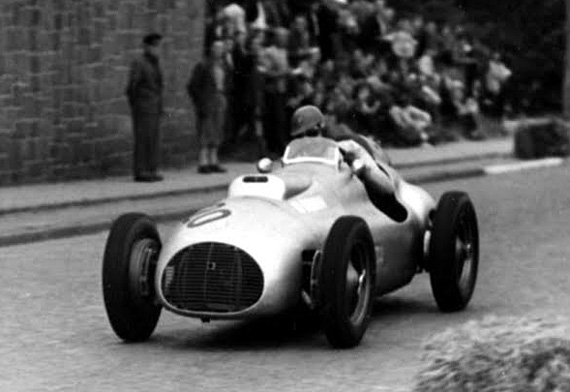
Hans Stuck in action at the 1950 German Grand Prix in the AFM-Kuchen. ( Photo Courtesy the Ludvigsen Library.)
Having digressed from the subject of the Balsa let me return. As you can see from the photos that Karl has sent, by courtesy of the Ludvigsen Library, it is quite a large engine and having looked at the photo of the Balsa, he feels that the engine would have been too big for the frame, but I am not too sure. As Karl also points out that Stuck bought just one engine, he confirmed that the second one went to someone in Switzerland and the third one was retained by Kuchen himself. So it is even more unlikely that the V8 engine in the Balsa was a Kuchen.
So what 2 liter V8 could it have been? Perhaps one of our readers can suggest an answer. You know, you can easily get lured into odd corners if you come across one-off racing specials in barns.
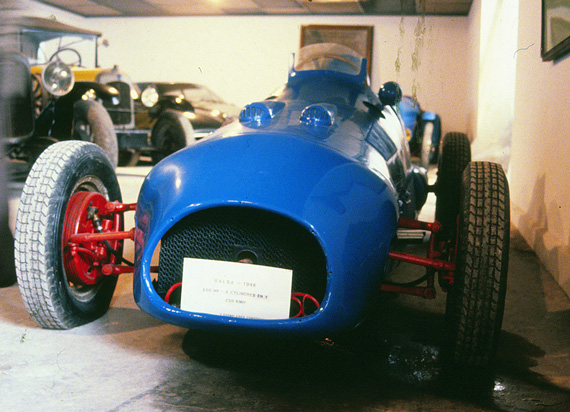
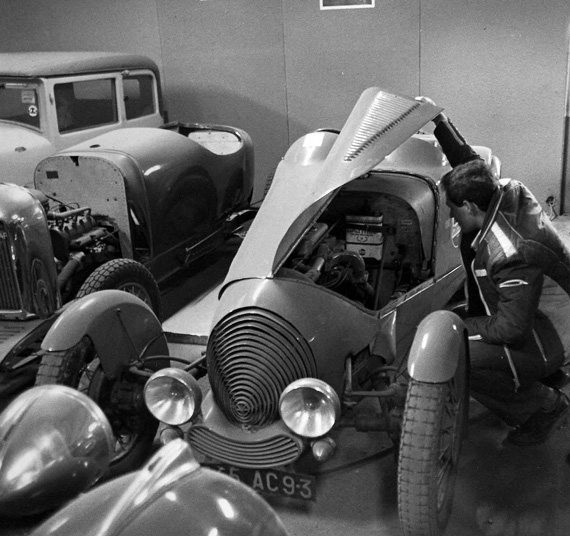
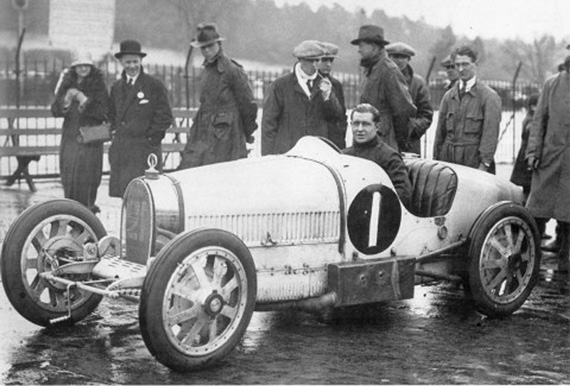
Congratulation, interesting story… I have just one remark: AFM was not an east German company. AFM means Alexander von Falkenhaúsen München. The company was supported mostly by Hans Stuck.
Fiat V8? Relatively narrow 70 degree, pretty light, 120 hp……
Balsa modified one car starting with six cylinder BMW. This car received later indeed a V8, but a Ford onecoming from the French Ford Vedettte. This update was made during the interseason 1952/1953.
Balsa didn’t make a one off, the car pictured is the the fourth one for Jean Judet, strating with original Ford V8,the car is often listed as F.A. or Ford Ardun.
Robert
From Gauld via the Ed…
Robert, of course the French Ford V8. Obvious when you think about it. Good to have the details updated–Graham Gauld